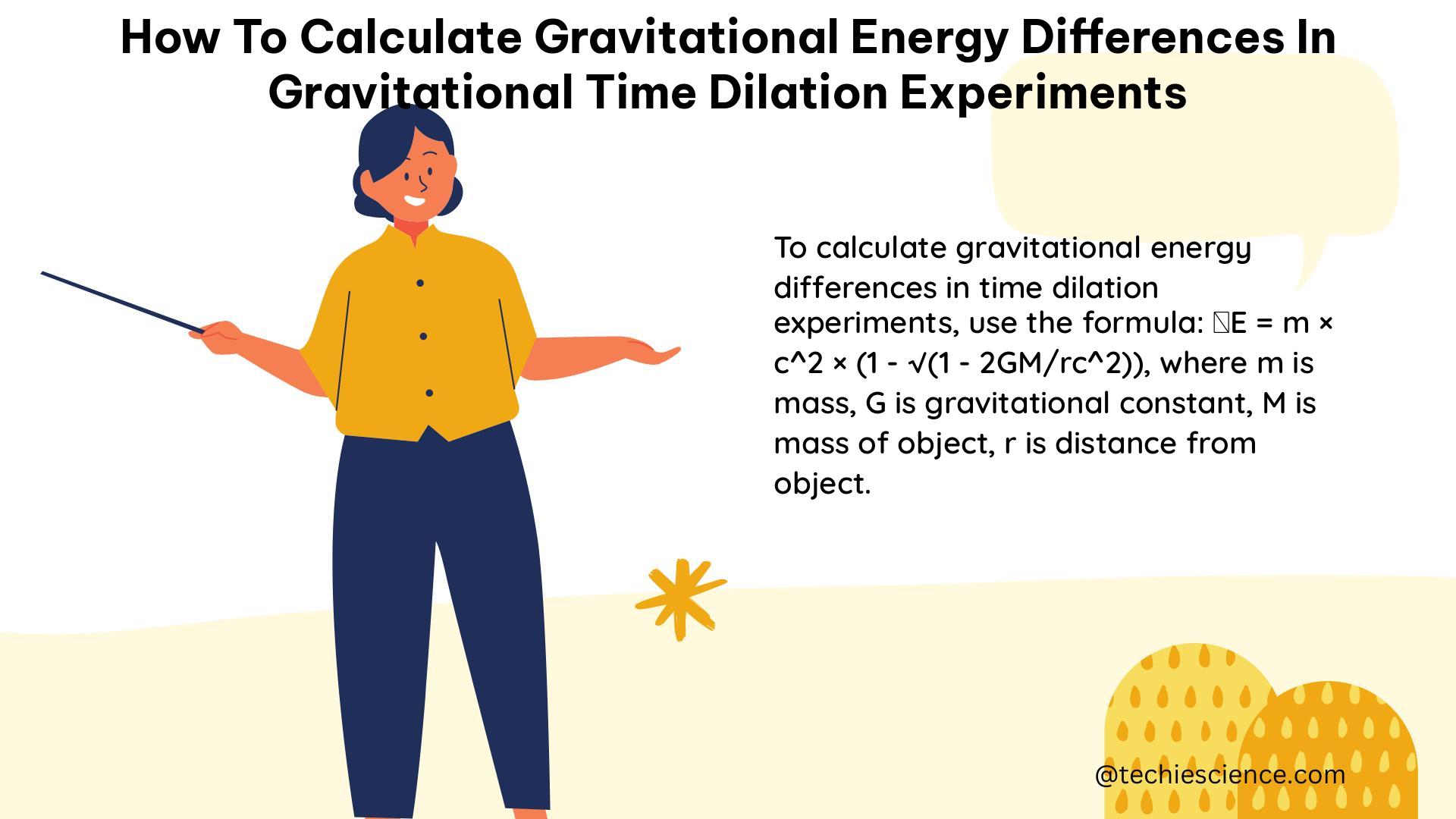Gravitational time dilation is a fascinating phenomenon predicted by Einstein’s theory of general relativity, where the passage of time is affected by the presence of gravitational fields. To understand and quantify this effect, we need to calculate the gravitational energy differences between two points in space. This comprehensive guide will walk you through the step-by-step process of calculating gravitational energy differences in gravitational time dilation experiments.
Gravitational Potential Energy
The foundation of understanding gravitational time dilation lies in the concept of gravitational potential energy. The difference in gravitational potential energy per unit mass between two points, A and B, is given by the formula:
$$\Delta\phi_{AB} = \frac{GM}{r_A} – \frac{GM}{r_B}$$
Where:
– $\Delta\phi_{AB}$ is the difference in gravitational potential energy per unit mass between points A and B.
– $G$ is the gravitational constant, with a value of approximately $6.674 \times 10^{-11} \text{ N m}^2 \text{ kg}^{-2}$.
– $M$ is the mass of the gravitating body, such as the Earth.
– $r_A$ and $r_B$ are the distances of points A and B from the center of the gravitating body, respectively.
This formula allows us to calculate the change in gravitational potential energy as we move from one point to another in a gravitational field.
Time Dilation

The relative time dilation between two observers, A and B, can be calculated using the weak field limit approximation, which is given by the equation:
$$\frac{dt_A}{dt_B} \approx \sqrt{ 1 + \frac{2\Delta\phi_{AB}}{c^2}} \approx 1 + \frac{\Delta\phi_{AB}}{c^2}$$
Where:
– $dt_A$ and $dt_B$ are the time intervals measured by observers A and B, respectively.
– $c$ is the speed of light, approximately $299,792,458 \text{ m/s}$.
This equation shows that the time dilation effect is directly related to the difference in gravitational potential energy between the two points.
Height Difference
In a constant gravitational field, such as on the surface of the Earth, the difference in gravitational potential energy between two points can be simplified to:
$$\Delta\phi_{AB} = gh$$
Where:
– $g$ is the acceleration due to gravity, which on Earth is approximately $9.8 \text{ m/s}^2$.
– $h$ is the difference in height between the two points.
This equation allows us to easily calculate the gravitational potential energy difference when the height difference between the two points is known.
Example Calculation
Let’s consider an example where we want to calculate the time dilation difference between two clocks, one at sea level and the other at a height of 1 km above sea level on Earth.
Given:
– Gravitational constant, $G = 6.674 \times 10^{-11} \text{ N m}^2 \text{ kg}^{-2}$
– Mass of the Earth, $M = 5.972 \times 10^{24} \text{ kg}$
– Speed of light, $c = 299,792,458 \text{ m/s}$
– Acceleration due to gravity on Earth, $g = 9.8 \text{ m/s}^2$
– Radius of the Earth, $r_A = 6,371,000 \text{ m}$
– Height difference, $h = 1,000 \text{ m}$
Step 1: Calculate the gravitational potential energy difference
Using the formula for gravitational potential energy difference:
$$\Delta\phi_{AB} = \frac{GM}{r_A} – \frac{GM}{r_A + h}$$
Substituting the values, we get:
$$\Delta\phi_{AB} = \frac{(6.674 \times 10^{-11} \text{ N m}^2 \text{ kg}^{-2})(5.972 \times 10^{24} \text{ kg})}{6,371,000 \text{ m}} – \frac{(6.674 \times 10^{-11} \text{ N m}^2 \text{ kg}^{-2})(5.972 \times 10^{24} \text{ kg})}{6,372,000 \text{ m}}$$
$$\Delta\phi_{AB} = 62,532.4 \text{ J/kg} – 62,528.4 \text{ J/kg} = 4 \text{ J/kg}$$
Step 2: Calculate the time dilation
Using the time dilation formula:
$$\frac{dt_A}{dt_B} \approx 1 + \frac{\Delta\phi_{AB}}{c^2}$$
Substituting the values, we get:
$$\frac{dt_A}{dt_B} \approx 1 + \frac{4 \text{ J/kg}}{(299,792,458 \text{ m/s})^2} \approx 1 + 4.45 \times 10^{-17}$$
This means that the clock at the higher altitude (1 km above sea level) will run faster by a factor of approximately $1 + 4.45 \times 10^{-17}$ compared to the clock at sea level.
Additional Considerations
- The gravitational potential energy difference and time dilation calculations become more complex when dealing with non-uniform gravitational fields or more complex geometries.
- In such cases, numerical simulations or more advanced mathematical techniques may be required to accurately model the gravitational effects.
- Experimental verification of gravitational time dilation has been a crucial test of Einstein’s theory of general relativity, with experiments conducted using atomic clocks, spacecraft, and other precision instruments.
- The ability to precisely measure and calculate gravitational time dilation has important applications in fields such as GPS, satellite navigation, and fundamental physics research.
Conclusion
Calculating gravitational energy differences in gravitational time dilation experiments is a crucial step in understanding and verifying the predictions of Einstein’s theory of general relativity. By using the formulas and techniques outlined in this guide, you can accurately determine the time dilation effects between two points in a gravitational field, providing valuable insights into the nature of space, time, and gravity.
References
- Wikipedia – Gravitational Time Dilation: https://en.wikipedia.org/wiki/Gravitational_time_dilation
- Physics Forums – Gravitational Time Dilation: https://www.physicsforums.com/threads/looking-for-laymans-physical-explanation-for-gravitational-time-dilation.276815/
- Wikipedia – Time Dilation: https://en.wikipedia.org/wiki/Time_dilation
- NASA – Gravitational Time Dilation: https://www.grc.nasa.gov/www/k-12/airplane/gtime.html
- American Physical Society – Experimental Tests of General Relativity: https://www.aps.org/publications/apsnews/201605/generalrelativity.cfm

The lambdageeks.com Core SME Team is a group of experienced subject matter experts from diverse scientific and technical fields including Physics, Chemistry, Technology,Electronics & Electrical Engineering, Automotive, Mechanical Engineering. Our team collaborates to create high-quality, well-researched articles on a wide range of science and technology topics for the lambdageeks.com website.
All Our Senior SME are having more than 7 Years of experience in the respective fields . They are either Working Industry Professionals or assocaited With different Universities. Refer Our Authors Page to get to know About our Core SMEs.